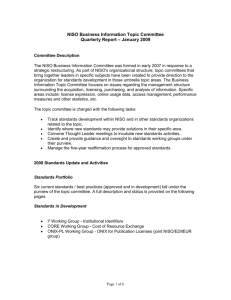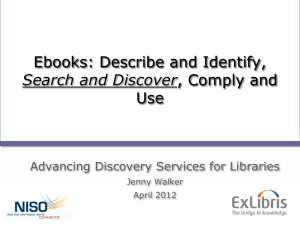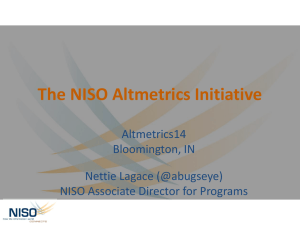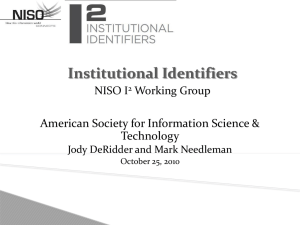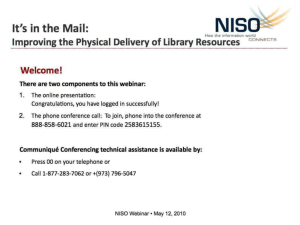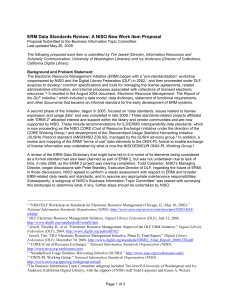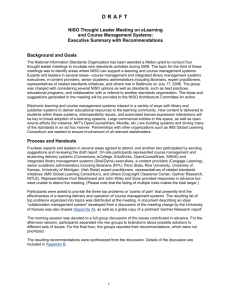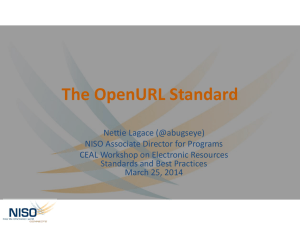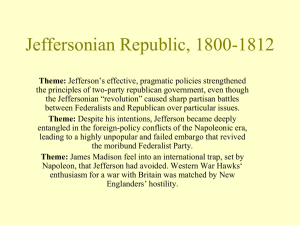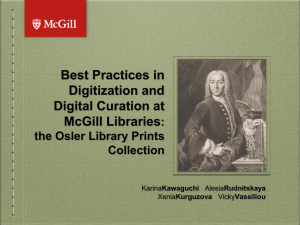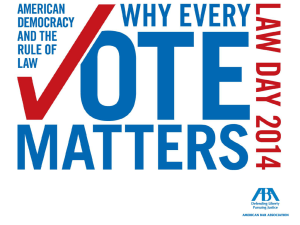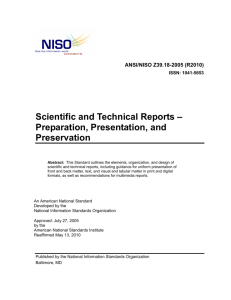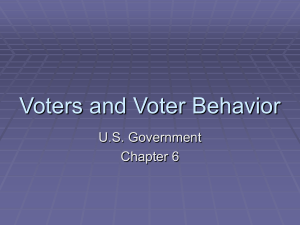NISO - An Introduction for New Committees
advertisement
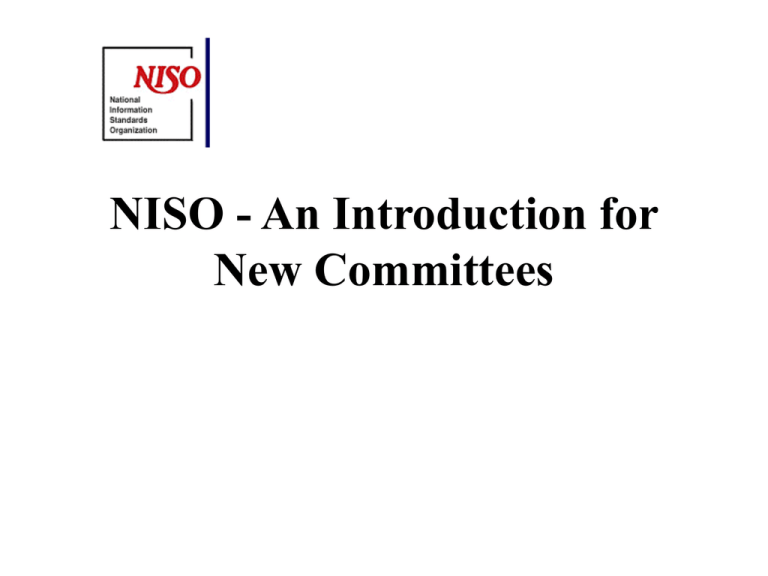
NISO - An Introduction for New Committees NISO History • Formed in 1939 • Originally known as ANSI Committee Z39 • ANSI Accredited - Follows ANSI consensus process • Manages US participation in related standards activities in ISO (International Organization for Standards) TC46 (Technical Committee on Information and Documentation) NISO Organization • Supported by Voting Members - currently around 70 - can accept non US based organizations as members • Executive Director - Pat Harris • Board of Directors • Standards Development Committee • Standards Committees - charged to develop a particular standard NISO Standards Development Committee • Responsible for overseeing the technical work of NISO • Decides on new work proposals to be undertaken • SDC members work as liaisons with individual committees NISO Constituency Major Constituencies Libraries National Libraries Library Associations Publishers Primary Publishers Secondary Publishers Abstracting and Indexing Organizations Aggregators Information Providers Library Automation Vendors Professional Societies Areas of Standardization Information Storage and Retrieval - e.g. Z39.50 Codes and Numbering Systems - e.g. ISBN, DOI Library Management - e.g. Library Statistics, Criteria for Price Indexes Preservation - e.g. Permanence of Paper Knowledge organization - e.g. Monolingual thesauri Publishing - e.g. Scientific and Technical Reports, Digital talking book Buildings, Furniture, Supplies - e.g. Shelving Metadata - e.g. Technical Metadata for Still Images Standards & Guidelines • Standards - Contain normative methods, materials, or practices which must be followed in order to be in conformance • Guidelines - non-normative recommendations all elements are discretionary and may be used as stated or modified to meet specific needs • Otherwise identical in terms of content, process NISO Proceedures • Based on ANSI Procedures • 4 Basic Components – – – – Openness (public record) Due process Balance of interests Consensus (not unanimity) (2/3 of those voting, excl. abstentions, as long as this = 1/2 of all Voting Members) Standards Process - New Proposals • Anybody can submit proposal • Proposals reviewed by SDC – is it within NISO scope? – Does it fill a need? – What is the technical, economic, and political feasibility of the proposal being developed? • If approved, Standards Committee may be formed Requirements for Standards Committee Members • Membership must be approved and supported by employer or parent organization • Must agree to commit the time required to do the work in timeframe specified in committee timetable • Must commit to attend the meetings of the committee Managing the Work of a Standards Committee • Plan a regular schedule of meetings - face to face, conference calls • Make use of electronic communications • Keep detailed and accurate minutes • Develop detailed work plan at first meeting • Meetings (including conference calls) are open to observers - however they may not participate in any Official votes of the committee Other Good Practices • SDC liaison is a resource - make use of it and keep liaison informed • Adopt techniques that will maximize speed of development • When defining glossary of terms make use of relevant definitions from other NISO standards to avoid duplication and differing definitions Standards Committee Work Plan • Detailed list of tasks necessary to accomplish committee charge • Timetable for completion that includes intermediate milestones - goal should be completion of first draft within 18 months keep timetable up- to- date as work progresses • Estimated budget for committee that includes such expenses as travel, telephone costs, consultant costs, etc Standard Development Phases • • • • • • Data gathering Drafting the proposed document Review and refinement Committee consensus Official ballot Responding to comments Data Gathering • Actively solicit data and input from interested and knowledgeable organizations and individuals • Gather and analyze relevant data on current practices • Gather and analyze relevant or proposed existing national, international, and other standards in the area Producing a First Draft • Appoint a committee member to be in charge • Consider assigning committee members specific responsibilities for sections of the document • Consider hiring an outside editor or consultant to help with writing - if technical writer not a member of committee - done in consultation with NISO Review and Refinement • Successive versions should be produced according to timetable in work plan • Ways to get review include: – circulating to NISO members for comment – posting a draft on NISO Web site – distributing to known experts – posting to relevant mailing lists – announcing availability of draft at professional meeting and conferences – giving presentations to increase awareness Committee Consensus • Committee must agree when a draft is ready for DSFTU or ballot • Draft should be stable and mature and technical content should be complete • A formal vote of the committee is required to show consensus has been reached • A two thirds majority of the full committee is required Draft Standard for Trial Use (DSFTU) • Way to get rapid, operational experience • Draft is published on NISO website and promoted • Feedback from implementations solicited • After 12-36 months, must be balloted (with or without revisions) or withdrawn Official Ballot • Committee prepares a submittal package that includes the draft standard and a report containing: – explanation of the significance and value of the document – major issues that were resolved in developing the document – changes introduced if a revision to an existing standard NISO Voting Positions - New Standards • Affirmative - supports approval without substantive change - comments may be provided • Negative with comment - does not approve reasons must be given along with specific actions which if taken would remove objection • Abstain with reason Responding to Comments • All comments must be acknowledged, fully considered and responded to • Committee must respond in writing within 60 days - committee may prepare an individual response to each commenter or prepare a composite response • All correspondence with commenters becomes part of the official record Addressing Negative Votes • All negative votes must be carefully considered, responded to, and a resolution sought • SC tries to convince voter to change vote: – by justifying existing text – by changing text Changes to a Draft • Committee must document and categorize all changes made to a draft after a ballot • Changes are of two types: – Substantive - requires a reballot – Editorial (including clarification) • Committee is charged with making a fair and honest categorization of changes Substantive Changes • A change that directly or materially affects those who will use the standard or guideline • Examples: – changing “may” to “must” or vice versa – changing any of the technical content or requirements Editorial Changes • Do not directly or materially affect the use of the standard or guideline • E.g. correcting misspellings, adding examples or words for clarification • Example: – Old: “ The identifier shall not exceed 50 characters” – New: “ The maximum length of the identifier shall be 50 characters” Fast Track Process • method for balloting fully formed documents that are not already ANSI standards, e.g. – ISO standards – NISO DSFTUs – standards out of non-ANSI agencies • document cannot be changed as part of process – revision and reballot procedures don’t apply – comments and negative votes must be responded to Reconsideration Ballot • If negative votes can not be resolved standard can still go forward (though rarely used) • Negative comments are sent to all NISO voting members who are given the opportunity to change their votes based on the comments • If no vote changes, standard can be forwarded to ANSI - there is an appeals process for negative voters at ANSI Approval ! • Standard gets official ANSI document number • Standard is published by NISO press • Standard is available free of charge from NISO website • Standards Committee is thanked and retired Maintenance • All requests for changes, clarification, corrections considered • May have maintenance agency assigned • Must be reviewed every 5 years and affirmed, revised, withdrawn • If not reviewed in 10 years, automatically withdrawn by ANSI For More Information • NISO website: http://www.niso.org • NISO Operating Procedures: http://www.niso.org/pdfs/OpProc.pdf • NISO Style Guide • Information Standards Quarterly
